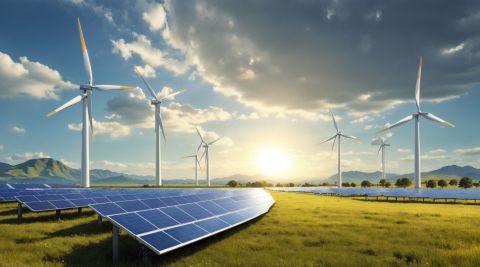Empowering the future with renewable energy
2025-03-19 14:00:41
In
the pursuit of a sustainable future, the global community has turned
its attention to harnessing the power of renewable energy. As climate
change accelerates and traditional energy sources dwindle, the demand
for clean, sustainable alternatives has never been greater. This article
explores the modern use of renewable energy, showcasing innovative
technologies and their impact on our planet, economies, and daily lives.

The Rise of Renewable Energy:
The
21st century has witnessed a remarkable shift in the energy landscape,
with renewable sources taking center stage. Solar, wind, hydro, and
geothermal power have emerged as frontrunners in the quest for cleaner,
more efficient energy. Governments, businesses, and individuals
worldwide are investing heavily in renewable infrastructure, recognizing
its potential to mitigate climate change and foster economic growth.
Solar Power Illuminates the Future:
Solar
energy stands out as one of the most promising and rapidly advancing
renewable technologies. The widespread adoption of photovoltaic (PV)
panels has transformed sunlight into a readily accessible and scalable
power source. With advancements in solar cell efficiency and decreasing
costs, solar energy is becoming increasingly competitive with
conventional fossil fuels.
Photovoltaic Innovations:
Cutting-edge
technologies such as perovskite solar cells are pushing the boundaries
of efficiency, promising cheaper and more flexible alternatives to
traditional silicon-based cells. These innovations open new
possibilities for integrating solar panels into various surfaces, from
windows to clothing, making renewable energy a seamless part of our
daily lives.
Solar Farms and Grid Integration:
Large-scale
solar farms are reshaping the energy landscape, capturing vast amounts
of sunlight to generate electricity for entire communities. Smart grid
technologies enable seamless integration, allowing surplus energy to be
stored and distributed efficiently. Battery storage solutions, like
lithium-ion and emerging technologies such as solid-state batteries,
play a crucial role in ensuring the reliability of solar energy during
periods of low sunlight.
Harnessing the Winds Potential:
Wind
power, another cornerstone of the renewable energy revolution, has seen
significant growth in recent years. Wind turbines, both onshore and
offshore, have become iconic symbols of clean energy production,
harnessing the kinetic energy of the wind to generate electricity.
Offshore Wind Farms:
Offshore
wind farms, situated in windy coastal areas, represent a frontier of
wind energy expansion. These projects boast higher wind speeds and fewer
land constraints, making them a powerful contributor to the energy mix.
Advances in turbine technology, including larger rotor diameters and
floating platforms, are driving increased efficiency and
cost-effectiveness in offshore wind installations.
Distributed Wind Energy:
Small-scale
wind turbines are gaining popularity in distributed energy systems,
providing localized power generation for homes, businesses, and remote
areas. These turbines are particularly useful in off-grid locations,
offering a sustainable alternative to diesel generators and reducing
dependence on centralized power grids.
Hydropower: A Time-Tested Energy Source:
Hydropower,
the oldest and most widely used form of renewable energy, continues to
play a crucial role in global electricity generation. Dams and
hydroelectric power plants harness the energy of flowing water to
produce electricity, offering a reliable and scalable solution for
meeting the worlds growing energy needs.
Sustainable Hydropower Practices:
Modern
hydropower projects prioritize sustainability and environmental impact.
Fish-friendly turbines, fish ladders, and improved water management
techniques mitigate the ecological consequences of dam construction.
Additionally, advanced monitoring systems enable real-time adjustments,
ensuring a balance between energy production and ecosystem preservation.
Geothermal Energy: Tapping into Earths Heat:
Geothermal
energy harnesses the Earths internal heat to produce electricity and
heat buildings. This form of renewable energy is particularly prevalent
in regions with high geothermal activity, such as Iceland and parts of
the United States.
Enhanced Geothermal Systems:
Innovations
in Enhanced Geothermal Systems (EGS) are expanding the reach of
geothermal energy beyond traditional hotspots. By injecting water into
hot rock formations deep underground, EGS can create artificial
reservoirs of steam, providing a sustainable and constant source of
geothermal energy.
The Integration of Renewable Energy into the Grid:
The
transition to renewable energy requires a comprehensive overhaul of
existing energy infrastructures. Smart grids, energy storage solutions,
and advanced control systems are essential components in ensuring the
stability and reliability of renewable energy sources.
Smart Grid Technologies:
Smart
grids leverage digital communication and automation to optimize the
generation, distribution, and consumption of electricity. By integrating
sensors, meters, and advanced analytics, smart grids enhance grid
reliability, reduce energy losses, and enable dynamic pricing models
that encourage efficient energy use.
Demand Response and Grid Flexibility:
Demand
response programs empower consumers to adjust their electricity usage
based on real-time grid conditions. This flexibility helps balance
supply and demand, reducing the need for backup power plants and
enhancing overall grid stability. As renewable energy sources inherently
exhibit variability, demand response becomes a vital tool for managing
the intermittency of solar and wind power.
Energy Storage Solutions:
The
intermittent nature of renewable energy sources necessitates effective
energy storage solutions to ensure a constant power supply. Battery
technologies, such as lithium-ion batteries, are at the forefront of
this revolution, providing scalable and efficient storage options for
both residential and utility-scale applications.
Advancements in Battery Technology:
Ongoing
research and development efforts are focused on improving battery
performance, durability, and environmental sustainability. Beyond
lithium-ion, emerging technologies like flow batteries, solid-state
batteries, and even biological energy storage hold the potential to
revolutionize energy storage, making renewable energy more reliable and
accessible.
The Economic and Environmental Impact:
The
transition to renewable energy is not only a response to environmental
concerns but also a driver of economic growth and job creation. As the
renewable energy sector expands, it stimulates innovation, reduces
greenhouse gas emissions, and enhances energy security.
Job Creation and Economic Growth:
The
renewable energy sector has become a major source of employment
globally. Jobs in manufacturing, installation, maintenance, and research
and development have surged, providing opportunities for a diverse
workforce. Governments and businesses recognize the economic benefits of
investing in renewable energy, as it not only creates jobs but also
attracts investments in a rapidly growing industry.
Environmental Benefits and Climate Change Mitigation:
One
of the primary motivations for embracing renewable energy is its
positive impact on the environment. By displacing fossil fuels,
renewable sources significantly reduce carbon emissions, air pollution,
and environmental degradation. This transition is a critical component
of global efforts to mitigate climate change and achieve sustainability
goals outlined in international agreements like the Paris Agreement.
The Future of Renewable Energy: Challenges and Opportunities:
While
the progress in renewable energy is promising, challenges remain in
achieving a fully sustainable and integrated energy system. Overcoming
barriers such as intermittency, energy storage limitations, and
geopolitical considerations will be crucial in shaping the future of
renewable energy.
Overcoming Intermittency:
The
intermittent nature of solar and wind power poses challenges to grid
stability. Advancements in energy storage, coupled with innovative grid
management strategies, are essential to address the variability of
renewable energy sources. Continued research into grid-scale storage
solutions and advancements in demand-side management will play a pivotal
role in overcoming intermittency challenges.
Advancing Energy Storage Technologies:











